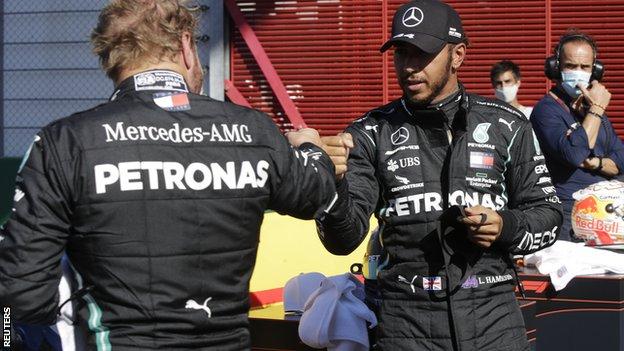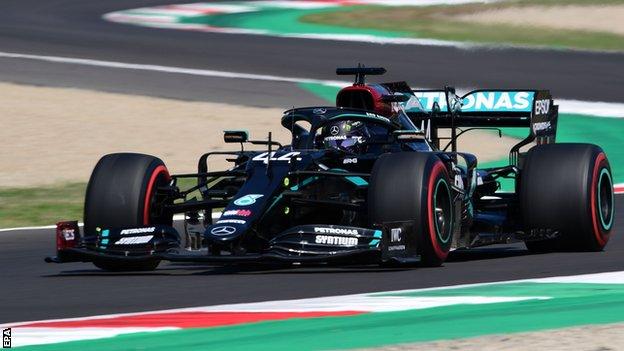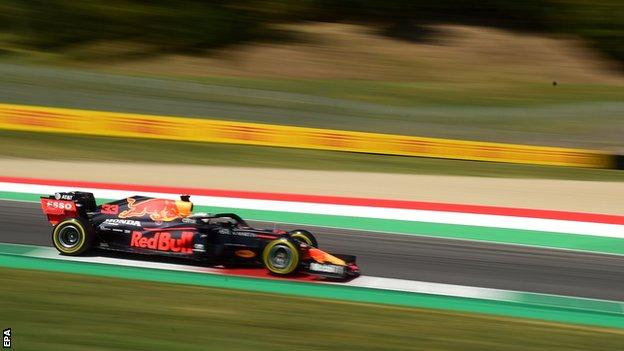
Valtteri Bottas must be starting to wonder what he has to do to beat Lewis Hamilton at all this year.
Bottas has not won a race since the opening grand prix of the season. And the last time he started ahead of his Mercedes team-mate in qualifying was at the 70th Anniversary Grand Prix at Silverstone in early August.
The Finn looked to have a great chance on Formula 1’s first visit to Mugello.
From the start of practice on the spectacular, fast and challenging track in the beautiful hills of Tuscany, Bottas had an edge on Hamilton. And yet come the end of qualifying it was Hamilton who took pole position. The 95th of his career. A century, remarkably, is not far away.
It was odd to see Hamilton struggle so through Friday and Saturday morning at Mugello, for one of his greatest strengths has always been his adaptability.
It’s something that is seen to best and most obvious effect in the wet, when he always excels in conditions in which grip levels change from lap to lap.

But it’s also seen, for example, in the first practice session at Monaco, when most drivers take time to build up to the limits to avoid an embarrassing and damaging trip into the walls. Hamilton does, too; it’s just he tends to be closer sooner than anyone else.
And the same goes for new tracks. And yet here was F1 at a new track, a particularly difficult one, one of which only a handful of drivers had experience, and Hamilton was on the back foot.
He had even spent time in the Mercedes simulator before the race to learn Mugello, but it had made no difference. And he was not sure why.
“I don’t really have a great answer for that,” Hamilton said. “I came here with the same mental approach. I tried to do extra work in the sense of doing the simulator.
“The first couple of laps in first practice looked good and then they just pulled away in terms of how much improvement everyone was making.
“For me, I would say some of it was balance. I was struggling with balance and at the end of the day it is confidence here. You have to really carry a lot of speed into these corners.
“It is a high-speed circuit and not wanting to put a foot wrong. And if you’re uncomfortable with the balance of the rear of the car, you pull back and then you’re just too slow at the apex and exit of a lot of these corners.”
Some of those corners have to be seen to be believed. The run through Turns Six, Seven, Eight and Nine is one of the most spectacular on any track anywhere. All are flat out.
On Hamilton’s pole lap, his minimum speed through Six – known as Casanova – was 177.1mph, then 175.8 at Savelli, and 176.5 and 170.9 through the two right-handers known as Arrabbiata, the loss of speed accounted for by tyre scrub.
Around a track of 15 corners, the cars generate lateral forces of more than 5G in seven. The drivers brake only six times. No corner is taken in lower than fourth gear in a Mercedes, and the changes in gradient and gravel traps waiting to catch any error are what saps that confidence if a driver is not happy with his car.
How Hamilton turned it around
Hamilton is not all about natural talent – he works at it, too. And it was there that lay the secret to his pole.
“Normally I tend to think one of my strengths was learning a circuit quite quickly and for this one we went on the simulator, which I never do, and I don’t feel like I benefited particularly,” he said.
“I was struggling to find the limit in certain sectors and Valtteri was miles ahead, really.
“The pressure was higher than ever because if I hadn’t done the work I wouldn’t have got the result we got at the end.
“There is an incredible amount of detail you have to go into, last night dissecting every single corner, basically, and sector and trying to fine-tune that set-up.
“There’s a real fine line between knowing whether you have understeer or oversteer and whether you are on the limit or not in certain places.
“You can be on the limit in one corner but not the rest. You can be on the limit in the first corner but not the second and then the third you are. So understanding whether you have the balance right within yourself and knowing what to request when you do move towards the limit to pre-empt what the car is going to do.
“There is a real science to it. It is not only the ability to drive, but to understand those things and to be engineers at the end of the day. We work with these geniuses who can balance numbers like nobody else but we need to be able to do that on the track.”
Hamilton was 0.53secs off Bottas in first practice, 0.207secs behind in the second session, 0.083secs behind in final practice, and took pole by just 0.059secs.
For Bottas, it was agonising. He felt more was in the car, but did not get the chance to turn things around on his second run after Esteban Ocon’s Renault went off at Turn Three.
Hamilton was ahead of Ocon and did get a second lap in, but did not improve, saying the circuit was slower because the wind had picked up, so it may have been academic anyway.
What chance Bottas in the race? His best hope is the start.
“It is one of the longest runs of this season into Turn One and if the headwind stays the towing [effect] will be quite powerful,” he said.
Red Bull back in business

The race may not be simply an in-house Mercedes battle, for the Red Bull of Max Verstappen tends to be a closer match in the races. And, after a dismal race last weekend at Monza, this was the closest the Dutchman has been to pole all year.
“From our side we did a very good job setting up the car compared to some other weekends where we have been a bit further away and I was not entirely happy with the car,” said Verstappen, who has been close to the Mercedes all weekend, and split them in two of the three practice sessions.
“We more or less maximised what we could do this weekend. We started straight away with a positive balance and the right wing level for our car. And maybe the track characteristics a bit, we seem to be bit better on higher-downforce tracks.”
He, too, had been putting in the homework – although in his case it meant renting a GT race car and coming to Mugello to learn the circuit and its secrets.
“I was here a few weeks ago,” Verstappen said. “It is not an F1 car but it gives you a better idea than driving on the simulator.
“I grew up driving on the simulator but I find it way better driving a real-life car. It gives you more of an idea of what lines you have to take because at the end of the day it doesn’t matter what car you are driving you are riding it more or less the same.
“That helped me a bit to get started. Also to set up the car. When I come here, I am not just cruising around, I am here working on the set-up and trying to make that car fast as well. And it gave me an idea of how to start with wing level and roll stiffness and things like this.
“When we started, the car was already in a very good window and I knew the track from a few weeks ago instead of a few years ago and that always helps.”
Can he do anything about the Mercedes in the race? Verstappen, well aware of the power of Mercedes this year, was not going to say that. But it is on his mind.
“For once we have quite decent top speed. It won’t be easy to pass but the track, the last few corners are wide and long so you can do a few different lines but it depends on if you have the pace to follow and tyre degradation.”